#Elrathia
Text
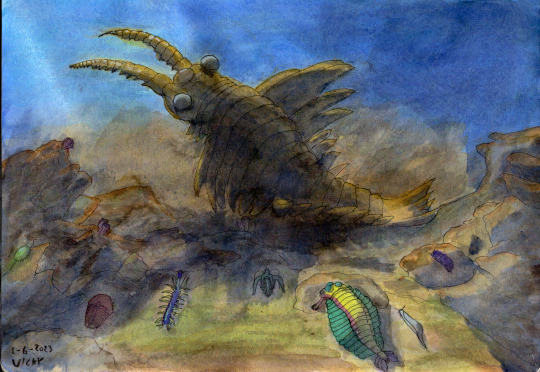
Mighty Anomalocaris stirs, spreading dust and terror throughout the Cambrian sea. Opabinia, Hallucigenia, Pikaia, Canadia, Burgessia, Marella, and Elrathia can only hope the rocks and ridges they cover behind will hide them.
#cambrian#anomalocaris#Opabinia#Hallucigenia#Pikaia#Canadia#Burgessia#Marella#Elrathia#hazelia#radiodont#arthropod#paleoart#my art#palaeoblr#lobopod#trilobite#chordate#sponge#cambrian explosion
175 notes
·
View notes
Text
FOSSIL FRIDAY and Happy December!
New month, new topics, possibly fresh snow in the next two hours (at least here in northern Utah).
Today, we are going to learn a little about index fossils!

Yes, Kirk, index fossils. Index fossils are part of Earth's record book. They are plants or animals that are characteristic of a particular span of geologic time or environment (usually both!). To be considered an index fossil a specimen must fulfill these 4 criteria:
1.) They must be DISTINCTIVE. If you can't identify it easily, it doesn't really help you much. Take Mucrospirifer, a type of brachiopod. That sucker is hard to miss!

2.) The must have a WIDE geographic range. If it's only found in, say southern Alberta, Montana and Wyoming, it's not terribly useful to anyone else. (Sorry Rexy, you're out!)

3.) It must be ABUNDANT. There has to be a lot of them. That's why most macrofauna doesn't work. There just aren't enough complete specimens. However, trilobites like this Elrathia are freaking EVERYWHERE.

4.) Finally, they must have a SHORT range through time. If you last too long, it makes it hard to pinpoint how old the rock is. The ammonite, Pavlovia, only lived during the Late Jurassic Period.
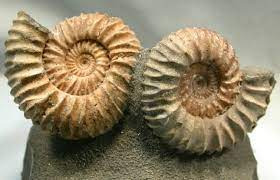
Index fossils are the basis for defining boundaries in the geologic time scale through a branch of geology called biostratigraghy (one of my areas of study. Love me some biostrat.) Examples of good index fossils include trilobites, brachiopods, and ammonites. All this month we are going to focus on one of these index fossils: Ammonites!
And, as always, if you like what you see here and want more content, you can always check out Minerals, Rocks and Fossil Talks on these other platforms:




Just look for this symbol below and you've got the right place! Happy Friday!

#paleontology#fun facts#fossils#geology#stratigraphy#biology#ecology#trilobites#ammonites#brachiopod
191 notes
·
View notes
Text


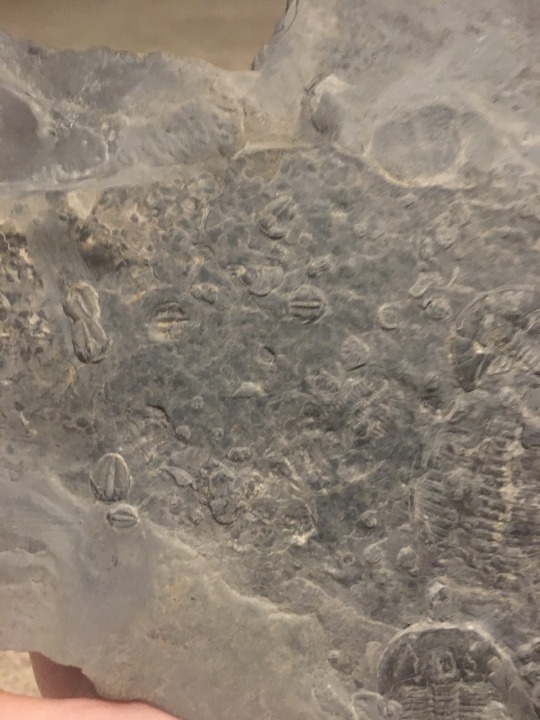
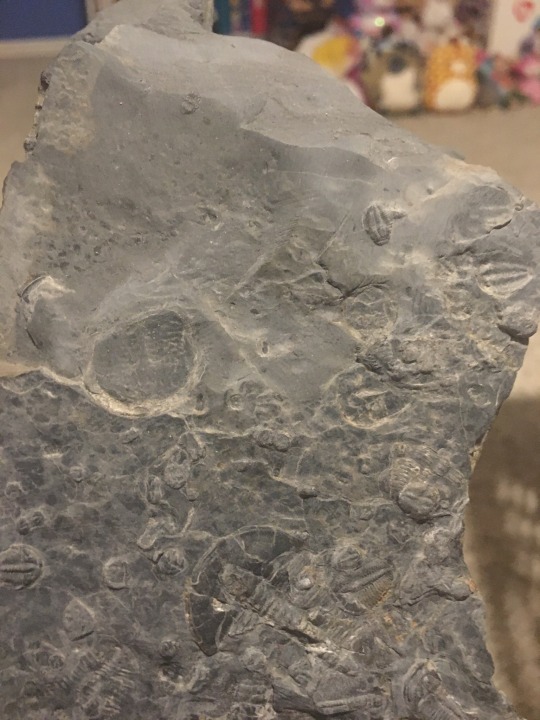
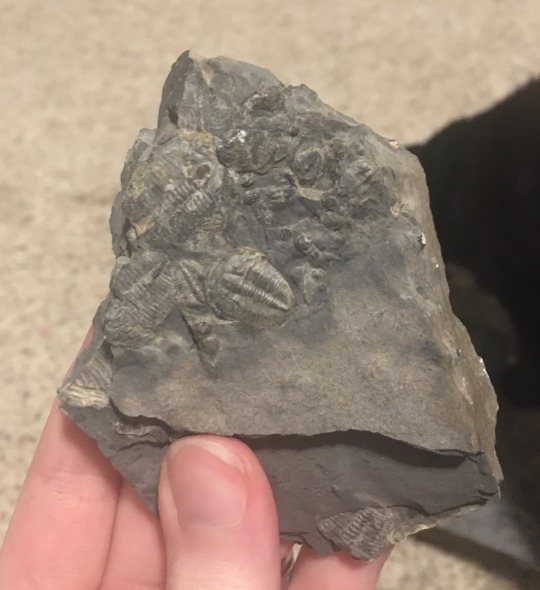

started thinking about fossil hunting so heres this super cool cambrian trilobite death assemblage i found at the wheeler shale last year
unfortunately it split into 3 pieces when i was trying to break it off from a boulder but w/e ive still got em
most of them are elrathia kingii but theres also some itagnostus interstrictus in there too!
2 notes
·
View notes
Text

This is a sterling silver pendant featuring an authentic, 505 million year old trilobite fossil from the Wheeler Shale of Utah. The species is Elrathia kingii, one of the most iconic and recognizable types of trilobite fossils.
0 notes
Photo
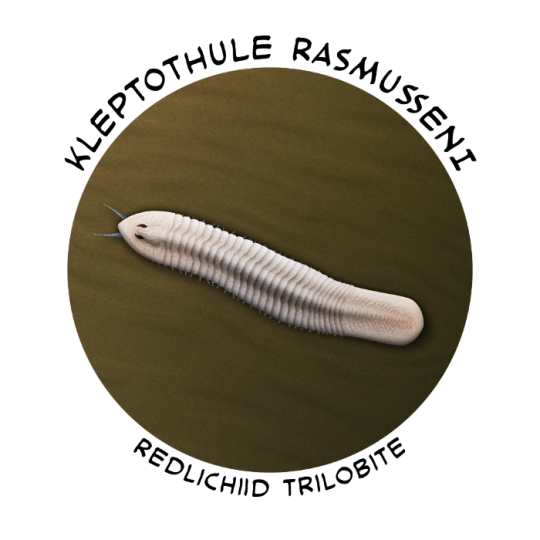

Cambrian Explosion #53: Trilobita – A Prolific Paleozoic Posse
The biggest stars of the Cambrian euarthropods, and most of the Paleozoic Era, were of course the trilobites. Known from literally tens of thousands of species spanning over 270 million years, they're some of the most recognizable and popular fossils.
Trilobites' exact evolutionary origins and transitional forms are unknown, but they're thought to have originated in Siberia in the very early Cambrian and their leg anatomy indicates they were a part of the artiopodan lineage. They made a sudden and dramatic entrance to the fossil record about 521 million years ago, appearing fully-formed and rapidly diversifying and spreading all around the world within just a couple of million years.
Their hard calcified exoskeletons made them much more likely to fossilize than soft-bodied animals, with a distinctive three-part body plan consisting of a head shield, three-lobed thorax segments, and a tail shield. Each individual regularly molted their carapace throughout their life, meaning that most trilobite remains are actually empty discarded shells rather than actual carcasses.
Along with being heavily armored arthropod tanks, most species were also able to roll themselves up to defend against predators, and some developed additional elaborate spines and spikes.
…And some were just weird.
Many trilobites had well-developed complex compound eyes with crystalline lenses (and some had elaborate "hyper-compound eyes"), but much of the rest of their anatomy is still poorly known, with only about 21 species found with preserved soft body parts. We do know they had a pair of antennae, biramous limbs with walking legs and feathery gill branches, and at least one species had a pair of cerci at its rear end, but there was probably a lot of soft-part diversity in this massive group that we'll just never know about.
I could easily spend entire months on trilobites alone, but there's still a handful of other major groups of Cambrian arthropods to get through as we head towards the final week of this series. So we only really have time for the barest glimpse at their ridiculous variety.
———
Some of the very earliest trilobites were the redlichiids, which ranged from about 521 to 500 million years ago during the early and mid Cambrian. They were more of an an "evolutionary grade" than a distinct lineage, giving rise to several other major groups during their time.
They were mostly fairly "standard"-looking trilobites with flattened bodies, although some had long spines or unusually large numbers of segments – up to 103 in one species.
Kleptothule rasmusseni was one of the odder-looking redlichiids, found in the Sirius Passet fossil deposits in Greenland (~518 million years ago). About 3cm long (1.2"), it had an elongated and relatively thin many-segmented body and a pointy head, giving it an almost snake-like appearance.
———
The ptychopariids were another very early group of trilobites but were somewhat longer-lasting, surviving until the end of the Ordovician about 444 million years ago. Much like the redlichiids they were more of an "evolutionary grade" splitting off various other major lineages during their existence – including the proetids, the group that eventually became the last trilobites to ever live at the very end of the Permian.
They were also fairly standard in appearance (with a few eyeless forms and odd exceptions), but they also include one of the most common and familiar trilobites in the world: Elrathia kingii.
Up to around 5cm long (2"), this trilobite is known from massive numbers of specimens (possibly in the millions) from the Wheeler Shale in Utah, USA (~507 million years ago). It had a wide thorax and short spines on the "cheeks" of its head shield, and seems to have been unusually tolerant of low oxygen conditions on the seafloor. It was one the earliest known animals to exploit such an environment, avoiding predators and competition, and it probably either grazed on sulfur-oxidizing bacteria or had evolved a symbiosis with them similar to modern giant tube worms.
———
Nix Illustration | Tumblr | Twitter | Patreon
#science illustration#paleontology#paleoart#palaeoblr#cambrian explosion#cambrian explosion 2021#rise of the arthropods#trilobite#kleptothule#redlichiida#elrathia#ptychopariida#trilobita#artiopoda#euarthropoda#arthropod#panarthropoda#ecdysozoa#protostome#bilateria#eumetazoa#animalia#art#so many trilobites
128 notes
·
View notes
Photo
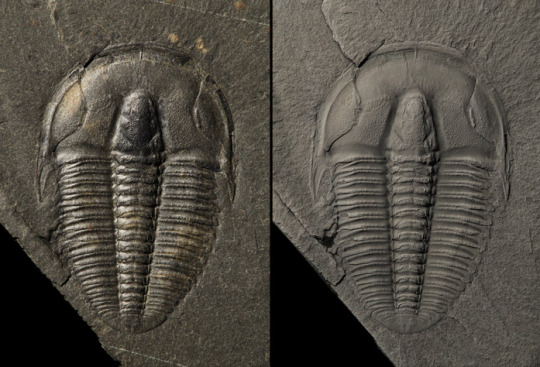
image credit: The Burgess Shale - Fossil Gallery
This fossil is Elrathia (specifically, the image is E. Permulta, a side chick, not E. Kingii, the main hoe ://), a genus that lived during the Cambrian Period in what we know today as Utah. They're not that big, usually less than an inch/few cm or mm in length, and tops, maybe 2 inches/5cm long. Elrathia lived in low oxygen environments (aquatic hypoxia) and - bc of their abundance - was prob pretty low on the food chain. The genus had a thorax (body) with 12-14 segments, depending on species, and maybe you'll notice that its structure is lowk similar to modern-day insects. That's bc they are ,, kinda,, related!! Class Trilobita and Insecta are both classes under the phylum of Arthopoda, which means that they're both animals, invertebrates w/ exoskeletons, have segmented bodies, and got dem paired + jointed appendages.
small-custard assessment: I give Elrathia a 8.5/10.
//yall should i rate the trilobite isoletus next?
#fossils#trilobites#elrathia#paleontology#palaeontology#elrathia kingii#burgess shale#dinosaurs#notreallyadinobuthashtagslol#fossil#cambrian#geology#small-custard assessment
145 notes
·
View notes
Photo
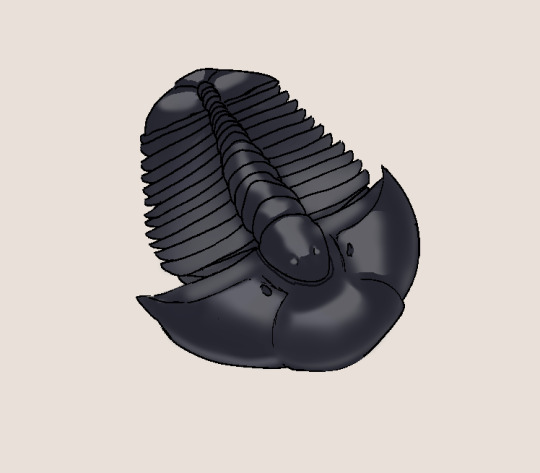
new fursona
10 notes
·
View notes
Link
#trilobite#fossil#elrathia#paleontology#paleoart#watercolour#watercolor#gouache#illustration#nhi#natural history#natural history illustration#redbubble#stickers#nhi101x
10 notes
·
View notes
Photo
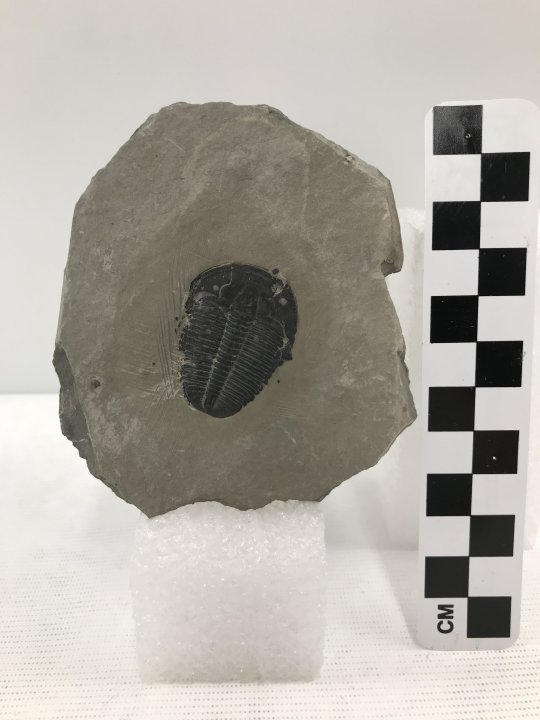
Trilobite (Elrathia kingii) fossil
Millard County, Utah, Middle Cambrian period
To help support the preservation of our collection click here.
#pacific grove#monterey#museum#collection#paleontology#trilobite#elrathia kingii#fossil#middle cambrian
3 notes
·
View notes
Photo
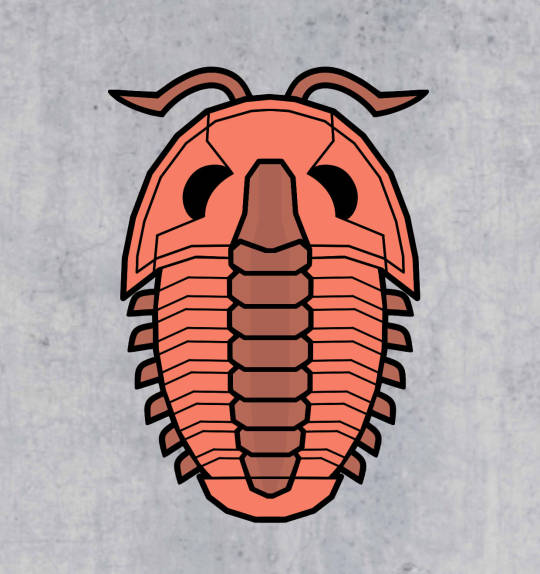
Elrathia, my favorite trilobite! Isn’t he just the cutest little thing?
#digital art#digital illustration#art#trilobite#paleoart#paleontology#arthropod#fossil#zoology#zoo#creature
87 notes
·
View notes
Photo

Trilobites! Itagnostus interstictus, Olenellus thompsoni, Paciphacops claviger, and Elrathia kingii. Not to scale, sizes are strictly done for artistic purposes. . . . #inktober #inktober2021 #inktoberchallenge2021 #inktoberchallenge #art #paleoart #prehistoriclife #prehistory #dinosaur #dinosaurart #prehistoric #trilobite #fossil #fossils #artwork #fabercastellbrushpen #fabercastell #traditionalillustration #traditionalart https://www.instagram.com/p/CVbuxqWMIIS/?utm_medium=tumblr
#inktober#inktober2021#inktoberchallenge2021#inktoberchallenge#art#paleoart#prehistoriclife#prehistory#dinosaur#dinosaurart#prehistoric#trilobite#fossil#fossils#artwork#fabercastellbrushpen#fabercastell#traditionalillustration#traditionalart
1 note
·
View note
Text
Update Time: Dinosaurs and Prehistoric Animals In Mass Media
A while back, I did a post on my findings for Dinosaur Representation in Film. Thanks to a project I’ve been aiding with, I’ve been able to greatly expand my media intact. From what I could watch (excluding the Simpsons, because how the hell am I gonna ID prehistoric life that cartoony), here are the top 10 prehistoric animals of various groups I’ve been able to log until about March of this year. Youtube always puts out something new, so I had to cut off some things.
This covers Movies, TV Shows, Educational Shorts, Direct to Video productions, Youtube Channels, and Youtube videos (for not largely dedicated prehistoric channels/playlists). This involved a lot of IDing I had to do myself. So when a documentary showed a mural or sculpture, I did my best to either deduce or track down the thing so I could ID things properly. Crystal Palace and Age of Reptiles showed up a LOT.
I even counted background skeletons for various museum shots when I could. Because I was going ALL IN on this.
And things that used 60% stock footage were not counted to avoid repetition. That said, footage from The Lost World (1925) got used a LOT, like, into the 21st century even!
As a final side note: SCREW Trilobites! They’re almost never IDed, and there are 40,000 of them!
Here is what I found out:
Top 15 Dinosaurs:
Tyrannosaurus - 306
“Raptor” (Velociraptor (90), Deinonychus (91), and Dakotaraptor/Giant Movie Villain Raptor (56) combined) - 237
Triceratops - 223
Apatosaurus ((121) and Brontosaurus(99)) - 220
Stegosaurus - 181
Allosaurus - 164
Basic Ornithomimidae (Struthiomimus (48), Ornithomimus (42), Gallimimus (30), Dromiceiomimus (8), Pelicanimimus (5), Archaeornithomimus (1) Combined) - 134
Edmontosaurus/Anatosaurus/Anatotitan - 124
Brachiosaurus - 121
Parasaurolophus - 121
Ankylosaurus - 97
Diplodicus/Seismosaurus - 93
Iguanodon - 82
Pachycephalosaurus ((56), Stygimoloch (15), Dracorex (8), and Alaskacephale (1) combined) - 80
Coelophysis - 73
Top 10 Birds/Stem Birds/Avilalans
Archaeopteryx - 84
Hesperornis - 26
Giant Moa - 23
Titanis walleri - 22
Ichthyornis (and related) - 21
Gastornis - 20
Phorurhacos - 18
Confuciusornis - 18
Teratornis - 17
Haast’s Eagle - 15
Top 10 Non-Avian Line Archosaurs
Crocodiles, Alligators, Caiman (Lumped Together) - 32
Postosuchus - 31
Sarcosuchus - 26
Desmatosuchus - 25
Deinoschus - 22
Smilosuchus - 17
Rutiodon - 17
Erythrosuchus - 17
Teleosaurus - 15
Tanystropheus - 15
Top 15 Prehistoric Mammals
Woolly Mammoth - 99
Smilodon - 83
Neanderthals - 73
“Cave Man (Cro-Magnon) - 64
Australopithecus - 59
Columbian Mammoth - 41
Equus ferrus (wild horse/tarpan) - 37
Mastodon - 37
Megalonyx - 37
Homo erectus - 36
Woolly Rhino - 36
Glyptodon - 33
Megatheirum - 32
Dire Wolf - 31
Gigantopithecus (including Kong and knockoffs of Kong) - 31
Top 10 Synapsids
Dimetrodon - 81
Edaphosaurus - 30
Inostrancevia/Giant Gorgonopsids - 28
Gorgonops - 25
Diictodon - 23
Placerias - 22
Lystrosaurus - 21
Moschops - 16
Lisowicia - 15
Tie: Estemmenosuchus, Secodontosaurus, Sphenacodon - 14
Top 10 Ancient Lepisosaurs
Mosasaurus - 66
Megalania - 30 (I lumped many a Slurpasaurus in here)
Tylosaurus - 30
Titanoboa - 17
Prognathodon - 14
Gigantophis - 9
Plioplatecarpus - 9
Platecarpus - 8
Dallasaurus - 7
Tetrapodphis - 7
Regular Iguana’s come in at #11.
Top 15 Pterosaurs
Pteranodon - 153
Quetzalcoatlus - 87
Rhamphorhynchus - 55
Pterodactylus - 45
Dimorphodon - 38
Ornithocheirus - 25
Geosternbergia (was once considered a species of Pteranodon, but they are easy enough to distinguish) - 24
Anuragnathus - 24
Hatzegopteryx - 22
Nyctosaurus - 16
Eudimorphodon also has a 16, but I flipped a coin for this list.
Top 10 Ichthyosaurs
Ichthyosaurus - 37
Ophthalmosaurus - 26
Temnodontosaurus - 19
Sonisaurus - 15
Mixosaurus - 13
Shastasaurus - 10
Cymbospondylus - 9
Eurhinosaurus - 7
Stenopterygius - 7
Cartorhynchus - 7
Top 10 Other Aquatic Reptiles
Elasmosaurus - 64
Plesiosaurus - 47
Nothosaurus/”Paleosaurus” - 24
Pliosaurus - 19
Kronosaurus - 18
Liopleurodon - 16
Placodus - 12
Dolichorhynchops - 10
Cryptoclidus - 8
Placochelys - 7
Top 5 Turtles
Archelon - 21
Megalocheluys atlas/Giant Tortoises - 11
Proganocheys - 10
Odontochelys - 7
Carbonemys - 6
Top 5 Primitive Reptiles
Scutosaurus - 26
Hylomnus - 21
Drepanosaurus - 14
Mesosaurus - 10
Sharovipteryx - 9
Top ~10 Prehistoric Amphibians
Eryops - 38
Ichthyostega - 32
Tiktaalik - 23
Mastodonsaurus - 19
Koolasuchus - 16
Seymouria - 16
Metoposaurus - 15
Prionosuchus - 14
Platyhystrix - 14
Diplocaulus - 14
Acanthostega - 14
Crassigyrinus is just short of being in the grouping.
Top 15 Fish and Sharks
Coelacanths (modern (23), Mawsonia (16), Coelacanthus (7), Rebellatrix (5), and Axelrodichthys (2)) - 53
Dunkleosteus - 32
Megalodon - 31
Lungfish (combined modern species and Necroceratodus) - 28
Xiphactinus - 26
Eusthenopteron - 26
Helicoprion - 24
Bothriolepis - 22
Onchopristis - 17
Orthacanthus - 17
Cretoxyrhina - 16
Hybodus - 16
Cheirolepis - 16
Cepjhalaspis - 15
Arandaspis - 14
Top 10 Arthropods & related.
Meganeura/Meganeuropsis - 59
Arthropleura - 27
Megalograptus - 26
Pterygotus - 24
Horeshoe Crab - 19
“Giant Spiders” - 18
Eurypterus - 18
Marella/Marellamorpha - 16
Pulmonoscorpius (Giant scorpion) - 14
Aysheaia - 12
Top 10 Trilobites
Generic Unnamed/Unidentified Trilobites - 38
Phacops - 24
REdlichia - 23
Isotelus rex - 20
Elrathia - 14
Dicranurus - 8
Asaphus - 8
Terataspis - 7
Olenoides - 7
Paradoxides - 7
If you don’t count the generic one, then the last slot is a tie for Harpes and Oryctocephalus (at 5 appearances each).
Top 10 Mollusks
Ammonite (Generic) (Identifying the various species of Ammonite by sight is as hard as the Trilobites) - 54
Cameroceras - 22
Belemnites - 20
Orthoceras - 16
Wiwazia 16
Nautilus - 15
Parapuzosia - 10
Clam - 10
Inoceramus - 9
Tusoteuthis/Giant Squid - 6
Top 9 Super-Primitive Basal Animals
Charnia - 20
Kimberella - 10
Dinomischus - 9
Amiskwia - 5
Ernietta - 5
Funisia - 5
Coronacollina - 4
Swartountia - 4
Cyclomedusa - 4
29 notes
·
View notes
Text
What’s in a fossil name?
What’s in a fossil name?
Dr Paul D Taylor (UK)
There’s a small Cambrian trilobite (Fig. 1) that is collected in copious quantities from a site in the Wheeler Amphitheatre of Utah. Sold just as it is or mounted in jewellery, this trilobite lacks a common name and goes by its scientific name. In its fullest form, this is Elrathia kingii (Meek, 1870). But what exactly do the different parts of the name mean? How did…

View On WordPress
1 note
·
View note
Video
goldbugsofficial
The most basic trilobite preparation of a red Elrathia kingii from Utah. Anyone can do this one! Using a micro air abrasion machine which works by utilizing a pressurized stream of particles to sandblast the surface. In this case the particles, or media, is 30 micron dolomite powder shooting at around 20 psi. The machine used is a Crystal Mark MV241 and the work chamber is a Crystal Mark Turbo Station which collects the spent powder and debris. Enjoy!
#Trilobite#fossil#geology#trilobitetuesday#fossil preparation#dolomite#sandblasting#mineral#rock#the earth story#instagram
376 notes
·
View notes
Text
Got a bunch o' fossils in today! They'll be on Etsy pretty soon!
We got one shiny Nautilus lad.
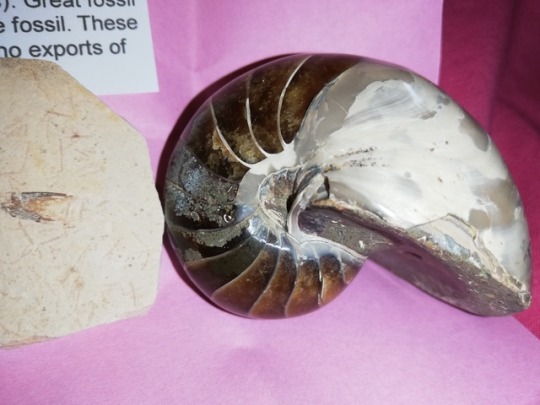
And this tiny fish friend!

(Casual reminder to refrain from buying Nautilus shells, buy their already long dead fossils and leave the alive bois we still have alone pls!)
There was also supposed to be some Elrathia kingii Trilobite friends but they have mysteriously disappeared, not even the supplier knows where they went, come home lads...
34 notes
·
View notes
Photo

TRILOBITES El primer fósil que tuve fue un trilobite. Era un Elrathia Kingii. Mi papá me lo compró en un viaje que hicimos en motorhome por los estados de Nuevo México, Colorado, Wyoming y Montana. Entonces no sabía una chingada de geología o paleontología pero ese bichito atrapado en una roca representaba para mí una fuerza tremenda de información y magia y de alguna manera intuía que había una relación profunda entre ese extinto animalito y yo. Años después me enteré de nuestro parentesco genético y con ello quedó claro que ni yo ni mi especie éramos ni mejores ni tan especiales como ese u otros animales extintos o vivientes: todos compartimos el mismo origen. Eso hace las cosas aún más interesantes. Mire: no somos el centro de la creación como tampoco debemos considerarnos la culminación del proceso evolutivo en el planeta (hay muchas otras especies más exitosas que nosotros y que seguramente van a continuar después de nuestra bien merecida y esperada extinción). Hay que entender que en el universo muy probablemente ya se dieron sistemas solares con planetas con vida que cumplieron su ciclo y desaparecieron; el nuestro es otro más de la lista. Pero este es el planeta y la vida que nos tocó y es maravilloso, con todo y los incipientes 80 o 100 años que nos toca vivir en promedio como individuos -nada en comparación del tiempo geológico y menos aún en relación al tiempo cosmológico-. ¿Llegará una especie inteligente a describir y descifrar nuestros fósiles en un futuro muy remoto? Sepa la madre. Al chile, no lo creo. Si comparamos el tiempo que vivieron los trilobites con lo que nosotros como especie llevamos existiendo pues hay que reir a carcajadas, porque es una fracción ridícula (y ciertamente espero que inconsecuente). Las acuarelas son mi interpretación de un Paradoxides y un par de Olenellus. Mi tatuaje es un Acidaspis.
1 note
·
View note